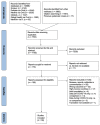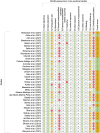Disruptions to routine childhood vaccinations in low- and middle-income countries during the COVID-19 pandemic: A systematic review
- PMID: 36034563
- PMCID: PMC9403570
- DOI: 10.3389/fped.2022.979769
Disruptions to routine childhood vaccinations in low- and middle-income countries during the COVID-19 pandemic: A systematic review
Abstract
Background: The COVID-19 pandemic has disrupted routine childhood vaccinations worldwide with low- and middle-income countries (LMICs) most affected. This study aims to quantify levels of disruption to routine vaccinations in LMICs.
Methods: A systematic review (PROSPERO CRD42021286386) was conducted of MEDLINE, Embase, Global Health, CINAHL, Scopus and MedRxiv, on the 11th of February 2022. Primary research studies published from January 2020 onwards were included if they reported levels of routine pediatrics vaccinations before and after March 2020. Study appraisal was performed using NHLBI tool for cross-sectional studies. Levels of disruption were summarized using medians and interquartile ranges.
Results: A total of 39 cross-sectional studies were identified. These showed an overall relative median decline of -10.8% [interquartile range (IQR) -27.6%, -1.4%] across all vaccines. Upper-middle-income countries (upper-MICs) (-14.3%; IQR -24.3%, -2.4%) and lower-MICs (-18.0%; IQR -48.6%, -4.1%) showed greater declines than low-income countries (-3.1%; IQR -12.8%, 2.9%), as did vaccines administered at birth (-11.8%; IQR -27.7%, -3.5%) compared to those given after birth (-8.0%; IQR -28.6%, -0.4%). Declines during the first 3 months of the pandemic (-8.1%; IQR -35.1%, -1.4%) were greater than during the remainder of 2020 (-3.9%; IQR -13.0%, 11.4%) compared to baseline.
Conclusion: There has been a decline in routine pediatric vaccination, greatest in MICs and for vaccines administered at birth. Nations must prioritize catch-up programs alongside public health messaging to encourage vaccine uptake.
Systematic review registration: Identifier: CRD42021286386.
Keywords: LMICs; child health; immunization; routine vaccines; vaccination hesitancy; vaccine-preventable diseases.
Copyright © 2022 Cardoso Pinto, Ranasinghe, Dodd, Budhathoki, Seddon and Whittaker.
Conflict of interest statement
The authors declare that the research was conducted in the absence of any commercial or financial relationships that could be construed as a potential conflict of interest.
Figures




References
-
- World Health Organization. Pulse Survey on Continuity of Essential Health Services During the Covid-19 Pandemic. (2020). Available online at: https://www.who.int/publications/i/item/WHO-2019-nCoV-EHS_continuity-sur... (accessed April 07, 2022).
-
- UNICEF. Covid-19 Pandemic Leads to Major Backsliding on Childhood Vaccinations, New Who, Unicef Data Shows. (2021). Available online at: https://www.unicef.org.uk/press-releases/covid-19-pandemic-leads-to-majo... (accessed February 09, 2022).
-
- World Health Organization. Second Round of the National Pulse Survey on Continuity of Essential Health Services During the Covid-19 Pandemic. (2021). Available online at: https://www.who.int/publications/i/item/WHO-2019-nCoV-EHS-continuity-sur... (accessed April 07, 2022).
-
- World Health Organization. Third Round of the Global Pulse Survey on Continuity of Essential Health Services During the Covid-19 Pandemic: World Health Organization. (2022). Available online at: https://apps.who.int/iris/handle/10665/351527 (accessed April 07, 2022).
Publication types
Grants and funding
LinkOut - more resources
Full Text Sources

